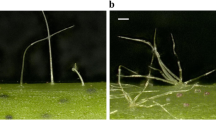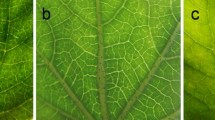Abstract
Five Australian wild cotton species with the delayed gland morphogenesis trait, as well asG arboreum, G davidsonii and four different gland genotypes ofG hirsutum, Gl2Gl2Gl3Gl2, Gl2Gl2gl3gl3, gl2gl2Gl3G3, and gl2gl2gl3gl3, were used in this experiment and 10 interspecific hybrids were obtained by the crossing among them. According to the gland expression on the seeds and plants of the interspecific hybrids, the inheritance of the delayed gland morphogenesis trait of Australian wild cotton species was opened out as follows: ( i ) the inheritance of the delayed gland morphogenesis trait was almost the same among the 5 Australian wild cotton species, and the gene or genes which controlled this trait may be located in the same loci. (ii) The glandless seed trait of the Australian wild cotton species was dominant over the glanded seed trait ofG arboreum, a genome A species, and the seeds of interspecific hybrid F1 between them were glandless. However, it was recessive over the glanded character of genome D species,G davidsonii, and their F1 was a typical glanded one. (iii) The glandless seed trait of the Australian wild cotton species was recessive or incomplete dominant over the glanded cotton but dominant over the glandless cotton ofG hirsutum, and the glandless genes (gl2gl2gl3gl3 of upland cotton had great weakening effect on the glanded plant trait of the Australian wild cotton species on the other hand. For the two main glanded genes of upland cotton, the delayed gland morphogenesis trait of the Australian wild cotton species was dominant epistatic over glandless genes, gl2gl2gl3gl3, and one of the glanded genes, Gl2Gl2, but was recessive epistatic over the other glanded gene, Gl3Gl3. Therefore, it is much convenient to use Gl2Gl2gl3gl3 as the upland cotton parent in the interspecific hybridization and backcrossing afterward, in order to produce the upland cotton germplasm with glandless seeds and glanded plant trait.
Similar content being viewed by others
References
Bell, A. A., Stipanovic, R. D., The chemical composition, biological activity and genetics of pigment glands in cotton, in Proc. Beltwide Cotton Prod. Res. Conf. Memphis (Tennessee, USA): National Cotton Council, 1977, 244.
Fryxell, P. A., A revision of Australian species ofGossypium with observation on occurrence ofThespesia in Australia (Malvaceae), Austr. J. Bot., 1965, 18: 71.
Muramoto, H., Hexaploid cotton: some plant and fiber properties, Crop Sci., 1969, 9: 27.
Wang, K. B., Li, S. H., Ye, W. W. et al., Cytogenetical studied on the interspecific hybrids ofG. hirsutum with 2 wild species in Australia, Acta Gossypium Cinica, 1994, 6(1): 23.
He, J. X., Sun, C. W., A scheme for introgression of delayed gland morphogenesis gene from wildGossypium bickii into cultivated upland cotton (G.hirsutum), Acta Genetica Sinica, 1994, 21(1): 52.
Li, B. L., Zhang, B. J., Zhang, X. R. et al., Studies on the hybrid betweenG.arboreum L andG. bickii Prokh, Acta Genetica Sinica, 1987, 14(2): 121.
Li, B. L., Zhu, S. J., Wang, H. M. et al., Bred and studied for a new allotetraploid germplasm with glandless seeds and glanded plant trait, ActaGossypium Cinica, 1991, 3(1): 27.
Jiang, R. Q., Zhong, W. N., Liang, Z. L. et al., Studies on interspecific hybrid ofG.hirsutum xG.sturtianum, ActaGossypium Cinica, 1990, 2(1): 31.
Hu, S. A., Study on the interspecific hybrid and its genetical character ofG.sturtianum xG.arboreum xG.hirsutum, in Proc. of Cotton Breeding Basic Research (in Chinese), Beijing: Agric. Press, 1987, 72.
Altman, D. W., Stelly, D. W., Kohel, R. L., Introgression of glanded-plant and glandless-seed trait fromGossypium sturtianum Willis into cultivated upland cotton using ovule culture, Crop Sci., 1987, 27(5): 880.
Dilday, R. H. Development of a cotton plant with glandless seeds and glanded foliage and fruiting forms, Crop Sci., 1986, 26: 639.
Mergeai, G., New perspectives concerning the methodology to be used for introgression of the glanded plant and glandless seed character in cultivated cotton (Gossypium hirsutum L.), Coton Fibres Trop., 1992, 47(2): 113.
Rooney, W. L., Stelly, D. M., Identification of fourGossypium monosomic alien addition derivatives from a backcrossing program with G.hirsutum, Crop Sci., 1991, 31(2): 337.
Author information
Authors and Affiliations
Corresponding author
About this article
Cite this article
Zhu, S., Ji, D. Inheritance of the delayed gland morphogenesis trait in Australian wild species ofGossypium . Chin.Sci.Bull. 46, 1168–1174 (2001). https://doi.org/10.1007/BF02900595
Received:
Issue Date:
DOI: https://doi.org/10.1007/BF02900595




